How To Draw Like Tim Burton
The Art of Tim Burton: The Artist Before The Filmmaker
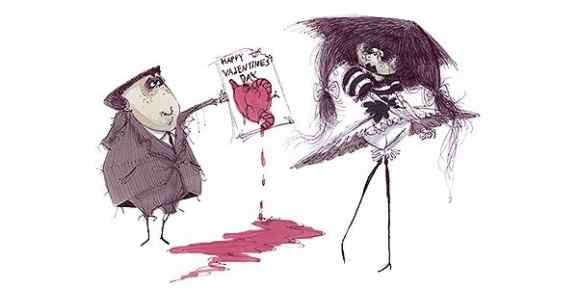
From the very moving Edward Scissorhands to the delirious Dark Shadows, Tim Burton has always been able to carry the audience away into the depths of his imagination. A world full of contradictions, both dark and light, frightening and welcoming, cruel and tender. A world where darkness cohabits with bright colours, where weird-looking people and monsters are brave and generous and where the horrible becomes poetic. Tim Burton has his own style that remains inimitable and his extravagance has become extremely popular. The audience is more familiar with his film work but few are aware of the origins of his films and of his creativity in general. Tim Burton is an artist before anything else. He is a talented drawer who expresses himself through his art. With him a film is often born from a little drawing at the corner of a page. The drawing already sets up the tone of the film, the colours of the set or the personality of a main character. This article pays tribute to the art of Tim Burton, not always well-known but always so rich and so meaningful.
A Compulsive Drawer
Drawing has always been part of Tim Burton's life. He expresses it as a need and a way to communicate his feelings and ideas. It is part of his everyday life and he always travels with a pencil in his pocket. He draws everywhere, at all time and on everything he gets his hands on. In Leah Gallo's and Holly C. Kempf's wonderful book The Art of Tim Burton (based on the exhibition at the MOMA) many of Burton's personal acquaintances pick on this compulsive need to draw and as his partner Helen Bonham Carter states 'with him, everything starts with a drawing'. He draws on at least ten notebooks at the same time and if he doesn't have paper he will use napkins, tissues, tables or walls. Extremely diverse and prolific, he uses different techniques and material – crayons, paints (oil, acrylic, watercolours), markers, pens, glitters and pastels… And with this he succeeds in creating whole worlds. His characters are born on paper, marginal and touching, misunderstood and passionate just like their creator.
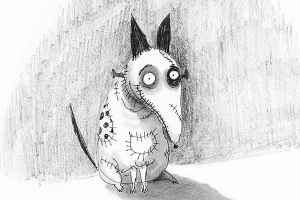
Burton describes this need to draw as a way to focus and to unleash his imagination. As a child, he often felt stifled and different from the other children. He drew monsters to escape the conformity of the American suburb he lived in (Burbank City) and art became his way out. He identified with his characters, timid and left out. Encouraged by his art teacher at school, he developed his own style and started to feel a true aversion for authority and categorisation. Being unusual gave him more artistic freedom and it became a characteristic trait of his art. He started to write and illustrate books for children and became a visual storyteller. As Rick Heinrichs, producer for Frankenweenie, says:
I've had the good fortune to see the images Tim dashes off to communicate an important thought to his collaborators. Economically but sublimely drawn, they often put across one simple-but-great-idea. His narrative temperament dictates an expressionistic visual style that selectively reveals the emotional heart of his story: one that entertains without burying meaning beneath multiple layers of expository clutter and gratuitous business'.
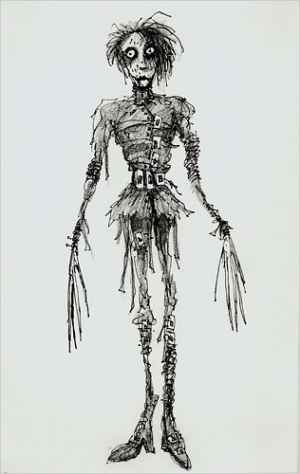
Tim Burton entered the California Institute of Art and worked in animation for Disney but was soon disappointed by the company's style, which was very different from his own. He was contrived to imitate and create pale imitations of Disney pencil traits with no soul and no emotion. All his independent projects were considered too bizarre to be screened and not adapted for children. It is only after leaving Disney studios that Tim Burton was able to free himself from artistic constrictions and focus on his art which he developed by embracing filmmaking. A film always starts with a drawing. Intuitive, enthusiastic and perfectionist, Tim Burton draws like he breathes. He has never separated his art work from his film work. Johnny Depp recalls his first collaboration with Burton:
"All I had the first time I went to work with Tim on Edward Scissorhands aside from the images arriving in my mind, was a tiny drawing that Tim had made. One look at that drawing was all I needed to understand what Edward was about. It has been exactly the same ever since."
His Inspirations
People have often compared Burton's style to the gothic. The use of black, the darkness of some of his drawings, the heavy make-up, the paleness of the skins, monsters and other ghostly creatures recall Gothic literature and paintings but also German Expressionism. The theme of death is omnipresent in Burton's art often combined with poetry and derision. The macabre becomes comic and poetic. He finds inspiration in the authors he loves like Edgar Allan Poe and Roald Dahl. He admires them for the unconventionality of their stories and the complexity of their worlds far from being just black and white. They are both funny and dark and close to Burton's own style.
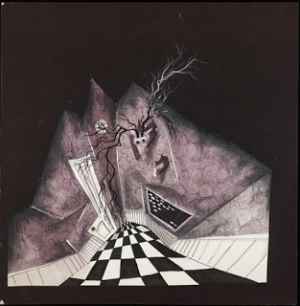
True film buff, Burton's inspiration can also be linked to the films he used to watch, mainly thrillers, low- budget films, satires, science fiction movies and cartoons. He identifies with Frankenstein and other monsters who are both feared and rejected. At the time he discovered those films, his universe started to expand and his creativity to grow. Watching Technicolor films helped him develop his use of colour in his drawings but also in his short films and he influence can be observed in Edward Scissorhands, with the profusion of pastel colours. He also loved punk music which expressed at the time his desire for rebellion against conventions.
His art is truly representative of his vision of the world and he also finds inspiration in the people who surround him. His drawings are often filled with social commentaries. He reveals the absurdity of our consumerist society and its hierarchical organisation. In one drawing he portrays the company Disney as a powerful dehumanizing machine which crushes any sense of singularity. He caricatures people and their behaviour from girls too obsessed by their physical appearance to a perverse man undressing a woman with his eyes, or a man covered in blood going in a gun shop and asking for more bullets. The suburbs he lived in also inspired him a lot and are at the heart of his film Edward Scissorhands.
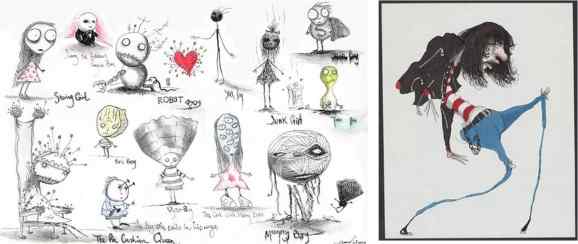
His Aesthetic and Message
Tim Burton refuses to become a label or a brand and doesn't categorize his art although others did it for him. His style is very recognizable, full of whirlwinds, stripes, seams, asymmetrical figures, winding staircases, monsters with sad eyes and weird hair. In terms of colours, he often uses black, white, purple, red and sometimes bright colours too. Through his drawings he captures feelings more quickly and efficiently than through words. He bases his style on simplicity, clarity, economy and rapidity. Here is how Ian Mackinnon, puppet creator and designer for Mars Attacks!, has described Burton's style:
'The real strength in Tim's artwork is his appreciation of form with strong shapes and exaggerated proportions. Within a few seemingly simple pen lines, he creates bold silhouettes […] You would be mistaken for thinking that some of Tim's rough sketches are rudimentary, loose or naïve, for they hold vital information, demonstrate a great delicacy, sensitivity, consistent keen eye, and a stunning vision'.
Tim Burton's imaginary world has now become a familiar one, a world everyone is drawn to. A world which is welcoming and heart-warming, filled with strange-looking people and sad clowns more frightened than frightening. His message is clear: people are not defined by their appearances. To be different does not mean to be excluded and differences should be cultivated along with singularity and creativity. His universe is more appealing than scary even though it is full of outcast characters. Their tragedy inspires more pity than fear and monsters become charming. He shows life as both kind and tragic, beautiful and cruel, funny and disturbing. The horrible becomes tender and poignant and it is the beautiful that becomes scary.
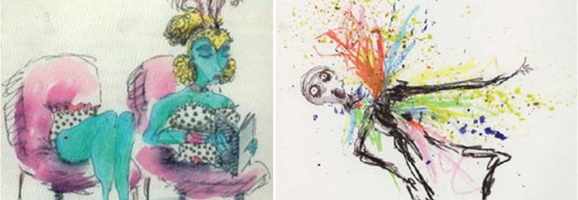
Work Cited
Tim Burton – Leah Gallo – Holly C.Kempf – Derek Frey, The Art of Tim Burton- Steeles Publishing – 2009
What do you think? Leave a comment.
Receive our weekly newsletter:
How To Draw Like Tim Burton
Source: https://the-artifice.com/art-tim-burton/
Posted by: kendallmouldither1967.blogspot.com

0 Response to "How To Draw Like Tim Burton"
Post a Comment